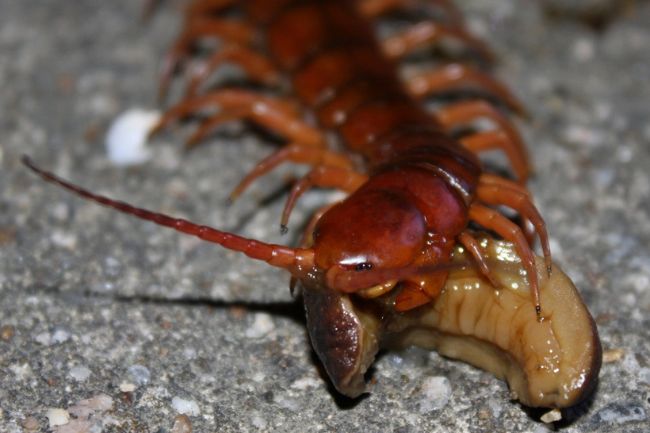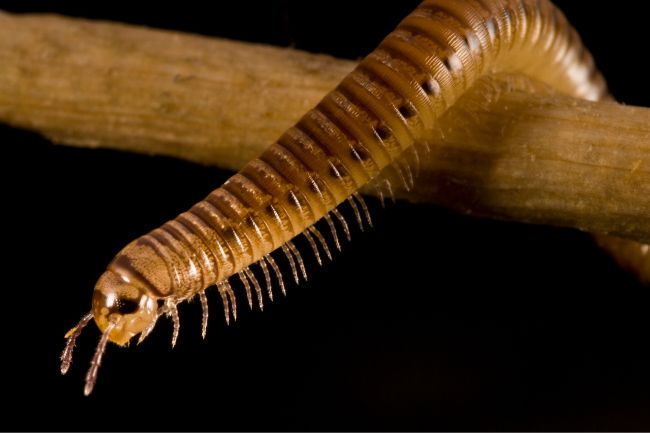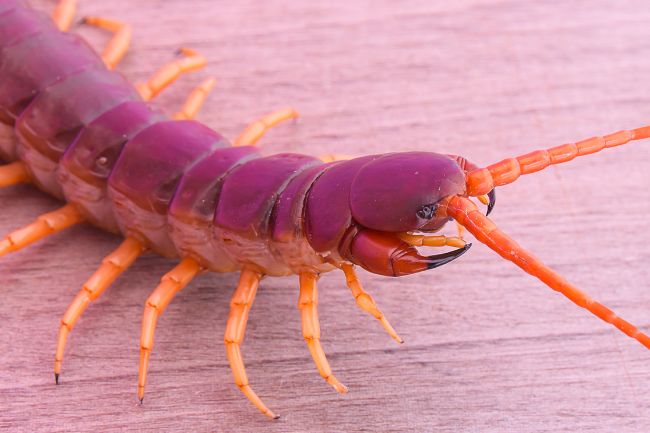Centipedes do have eyes, but the type they have depends on what kind of centipede they are. Some centipedes have compound eyes and simple eyes, some have only simple eyes, and some have no eyes at all.
Contents
What are eyes?

Eyes are sensory organs that many animals use to capture and process light, which allows them to ‘see’. Eyes come in many different forms, largely because different species require different kinds of data. Simple eyes, or ocelli, are usually used to detect levels of light, whereas compound eyes, which are made of many ocelli, can collect much more varied information.
Human eyes, for example, can see light on what is known as the ‘visible light spectrum’. This includes red light that many animals cannot see. However, we cannot see ultraviolet light, which many insects such as butterflies and bees can detect. Under ultraviolet light, flower petals can appear completely different, often with clear markers pointing pollinators towards the centre of the plant.
There are even differences between the same types of eyes. Mammals largely have the same sort of eye, a camera-type eye. However, pupil shape can vary a great deal, with predators up to a certain size often having vertical pupils, whereas grazing prey animals generally have horizontal pupils. These helps the prey to spot predators on the horizon, whereas predators can focus in on prey on the spot.
Also read: Do Butterflies have Eyes? What do They See?
How many eyes do centipedes have?

When it comes to eye design in centipedes there’s no straightforward answer. There are around 3,000 species of centipede across the world, though it’s thought around 8,000 may exist. Between the different species we have those with compound and simple eyes, just simple eyes, and no eyes at all.
The reasons for this difference is probably down to where these centipedes live and how they hunt. All centipedes are hunters, eating a wide range of animals. Smaller species tend to eat insects, spiders and molluscs. Larger species, such as the giant centipedes, might eat amphibians, rodents or even birds.
| Centipede Species | Number of Eyes |
|---|---|
| House Centipede | Around 15 pairs of eyes |
| Tropical Centipede | Up to 20 pairs of eyes |
| Stone Centipede | 2 to 8 pairs of eyes |
| Desert Centipede | 15 to 177 pairs of eyes |
| Soil Centipede | Around 15 pairs of eyes |
| Red-Headed Centipede | Around 20 pairs of eyes |
| Giant Centipede | Up to 100 pairs of eyes |
| Amazonian Centipede | Up to 100 pairs of eyes |
Most centipedes also spend their time in darkness, making eyes less important. This darkness might be self-imposed, as many species live in the soil, or below rocks and leaf piles. Or it might be in terms of being active only at night.
Larger species are often more likely to spend their time above ground, and therefore can have more benefit from being able to see. Using sight as part of hunting or defence can be useful to these species.
Also read: Millipedes and Centipedes – The Difference Explained
No eyes

There are a number of different centipede species that do not have eyes. This includes most centipedes within the geophilomorphs group, as well as many in the Scolopendromorpha. Most species that do not have eyes ted to be those that live below ground. Within the darkness of the soil, eyes would not give any useful data.
While living without sight might be seen as a serious impairment to us as humans, for animals like centipedes, there are other ways of receiving and processing information. Centipedes have large antennae, that sit on their heads. Antennae are wonderful sensory organs, able to pick up chemical signals given out by food, threats or other centipedes.
As well as chemicals, many antennae can sense touch, heat as well as other important sensory information. The type of information they can detect are often tailored to what the animals will find most useful, and can even vary between similar species.
With these antennae, eyesight isn’t so relevant for our little centipedes, as they are able to find their way, and hunt down their food, without being able to see a thing.
Also read: Wondering if “Millipedes have Antennae?” (Sensory Organ)
Simple eyes
Ocelli or simple eyes, are something that many insects have, particularly in juvenile phases. Many caterpillars only have simple eyes, whereas they have compound eyes as adults. Simple eyes are not able to process light in a very complex manner. Usually, all they can detect is the light level, and perhaps some very fuzzy images.
For centipedes, simple eyes can either be their main source of sight, or paired with more advanced compound eyes. When paired with compound eyes, they usually help to sense light levels, which can let centipedes know when they are out in the open. This is important for these creatures to know, as they dry out very quickly when not in a moist environment.
Centipedes from the Lithobiomorpha usually have simple eyes, as well as and many Scolopendromorpha. Centipedes in the Scolopendromorpha sometimes have four ocelli on either side of their head.
Those species with only simple eyes usually have very poor eyesight, and again will likely use it to mostly to detect light levels.
Also read: Do Ants Have Eyes? How and What do They See?
Compound eyes

Very few centipedes have compound eyes, probably because they don’t have much of a use for them. Many species within the Scutigeromorpha have compound eyes. These ‘house centipedes, such as Scutigera coleoptrata, live within human homes, allowing them to remain active all year.
The reason for their compound eyes, is unknown, but probably aids them in their hunting.
How well can they see?

Most centipedes don’t see very well at all, either having no sight, or being only able to see only different levels of light, or rough shapes. This is likely because they spend so much time in darkness, and can rely so heavily on their antennae instead.
Also read: Centipedes in Your Garden: Good or Bad?
Why do they need them?
Like all animals, light is another type of data they can gather and used to make their lives a little easier. They might use this data to find food, avoid predators, or track down mates. Because the data that most centipedes collect is very simply and not very in depth, being just light levels, one of the main ways they probably use it is to avoid the light.
| Eye Function | Explanation |
|---|---|
| Sensory Perception | Centipedes’ eyes are used to detect and perceive their surroundings, allowing them to navigate and locate prey. |
| Light Sensitivity | Eyes enable centipedes to detect changes in light intensity, helping them distinguish between light and dark areas. |
| Prey Detection and Capture | Eyes play a crucial role in detecting and tracking prey, allowing centipedes to accurately strike and capture their targets. |
| Movement and Navigation | Centipedes use their eyes to navigate complex environments, avoiding obstacles and finding suitable hiding places. |
| Predator Detection | Eyes help centipedes detect potential predators, allowing them to take evasive actions and ensure their safety. |
| Mating and Courtship Behavior | Eyes may also play a role in centipede courtship displays and mating behaviors, facilitating communication between individuals. |
| Distance and Depth Perception | Centipedes’ eyes provide depth perception, allowing them to gauge distances accurately, particularly during movements and hunting. |
| Environmental Awareness | Eyes contribute to centipedes’ awareness of their environment, including temperature, humidity, and potential threats. |
If you lift up a stone, you will often see lots of little legs scurrying away. This is because you are behaving just like a predator, hunting for taste bugs. For animals that live in the dark, sudden brightness may mean they are under attack, so they run back to the darkness to hide. Another issue can be that the light means they are no longer somewhere dark and damp. If they start to heat up and dry out, they will die. Again, a reason to avoid the light.
So, while centipedes may not have the wonderful range of vision that we humans have, they have enough to get by with what they need. After all, why waste time and energy on a complex eye that can detect red and green and blue, when most of the time you spend your life in the dark? For most centipedes, after all, light means danger and the darkness is their closest friend.

